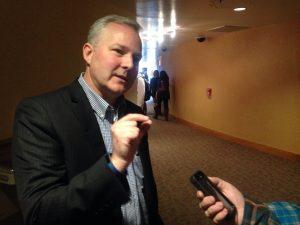Arkansas hopes to STEM the gap between genders and science and technology fields
by November 15, 2016 6:42 pm 243 views

Diana Smith never realized when she started college she would become a trend setter. The biology and pre-med student at Arkansas State University chose a field that requires heavy doses of math and science classes. Many girls decide to avoid science, technology, engineering, and math (STEM) careers when they attend college.
The Arkansas STEM Coalition and Wal-Mart Stores have teamed to recruit 5,000 volunteer mentors in the state to encourage more girls to go into these disciplines, Arkansas Lt. Gov. Tim Griffin told Talk Business & Politics. Griffin and others spoke at an event Tuesday on the ASU campus in hopes of enlisting local schools to the cause.
“The types of jobs we want to recruit to the state are high paying and sustainable … many are STEM based,” Griffin said. “We have to train more STEM workers in Arkansas. It’s that simple.”
Upon graduation, about one out of every two male high school students at least considers a career path associated with STEM, Griffin said. Only one out of every nine girls considers such a path, he said. Arkansas is desperate for workers with those skills, so it’s obvious where state leaders need to look, he said. Griffin has toured the state this year as part of the national Million Women Mentors movement. The goal is to enlist 1 million mentors nationwide by the end of the year, and 2 million by 2020, Walmart Market Health and Wellness Director Suzanne Hightower said. In Arkansas, 2,500 have signed up so far, she said.
Walmart employs 18,000 pharmacists and optometrists and pharmacies are one of the few science-based businesses dominated by women, she said. Mentors are required to spend at least 20 hours a year encouraging females about the virtues of a STEM education, she said. Mentors are also required to attend at least one STEM-related program a year.

Mentoring can start in middle school and can last until the student reaches the career stage, officials said. Students from Nettleton, Blytheville, and Hoxie attended the meeting on the ASU campus. The goal is to sign school and other organizations up for the program, and then have them identify and recruit mentors and mentees, Hightower said. Arkansas STEM Coalition Director Dr. Suzanne Mitchell the 150 or so people in attendance the goal is to make Arkansas’ workforce competitive on a global scale. Females are often not as confident as males when it comes to careers in these disciplines, and it’s a pattern that must change if the state is going to remain economically viable, she said.
“Arkansas is building a robust STEM pipeline,” she said.
The problems are not just in the high school system. Many female students who begin STEM-related majors as freshmen drop out of the programs within the first year or two, said ASU College of Science and Mathematics Associate Dean Dr. Anne Grippo. To combat this problem, the university has instituted an in-house mentor program to help keep these female students on the right path, she said.
Jobs in these fields are lucrative and employers are more likely to promote a person with a STEM background than ones from other educational and work disciplines, Griffin said. His neighbor, and former babysitter for his children, got a degree as a pharmacist and received a job offer of almost $150,000 upon graduation, Griffin said. The money and opportunities may be plenty, but the work is exhaustive, Smith reiterated.
“A lot of students don’t want to go into STEM because it’s hard. … It is hard,” Smith said. “But, you can do anything you put your mind too.”
